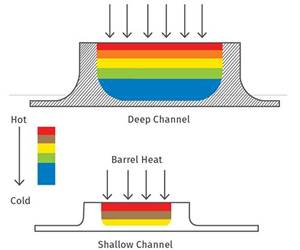EXTRUSION: How Slow Can You Go?
Larger screws designed for high outputs will generate a variety of problems if run too slowly. Here’s why.
Extrusion screws primarily plasticate or melt polymers by introducing energy into the material by shearing it. This shear or “viscous dissipation” is essentially achieved by “stretching” the polymer. In an extruder, of course, a screw rotates in a stationary barrel, and the polymer is assumed to stick to the barrel and to the screw, or to polymer that rotates with the screw. This stretching or shearing is a conversion of mechanical energy to heat by the drive rotating the screw in a viscous liquid.
It’s probably a lot easier to understand this principle if the flights were removed from the screw. Picture a solid cylinder turning inside a hollow cylinder filled with a viscous liquid. Imagine rotating the inner cylinder using a hand crank, with the stationary cylinder filled with a very stiff grease. It’s going to take a lot of work from you to rotate that crank, and that work will be transferred to the grease and converted to heat. If you can rotate the shaft fast enough and long enough the grease will get hot. The thinner the layer of grease between the two cylinders, the higher the shear stress in the grease and the faster the grease will get hot.
An extrusion screw works on that same principle. In an extruder, screw flights added to the inner cylinder allow for transport of material through the cylinder while generating pressure and improving melting. This is what distinguishes an extruder from a churn.
At very low speeds, the screw is limited in the amount of energy it can introduce into the polymer, just as you would use less energy to turn the crank at lower speeds. With less energy introduced, it makes sense to have a very shallow screw so it takes less time to heat it up. If the screw channels are shallow enough, it’s possible to melt the polymer largely using viscous dissipation even at very slow speeds.
Viscous dissipation is much more effective at melting polymers than conducted heat because polymers have poor thermal conductivity. Heating by viscous dissipation is proportional to rotational speed; so as speed is reduced, the melt-film layer adjacent the barrel wall formed during melting is reduced in thickness. This lengthens the distance required for complete melting in the compression section (conventional or barrier section); and once the solids leave the compression section, the shear stress is so low at low speeds that little further shear melting occurs.
Depending on conducted heat from the barrel is very limiting at that point because of the poor thermal conductivity or insulating properties of polymers. Conductive heating is particularly ineffective for crystalline polymers; a substantial temperature differential between the unmelt and the surrounding melt is necessary to supply the “bump” of energy to overcome the heat of fusion. Using very shallow sections allows for more effective viscous dissipation and requires shorter distances for more conducted heat to travel from the barrel. This combination of heating mechanisms may allow for very slow screw speeds.
The problem really comes to light when larger screws designed for much greater outputs are run at low speeds. The channels on these screws have too much depth to allow for sufficient melting by viscous dissipation at low speeds, making them dependent on conductive heating. This results in poor melt quality, unstable output, and large temperature differentials in the extrudate. The larger the extruder, the more problematic this becomes.
Each extruder screw has a range of operating speeds, depending on its design. If run too slowly, they will not provide adequate energy transfer for melting. Single screws are not universally designed to provide the desired melting capacity at all rotational speeds. In the medical field, in particular, there are expanding applications for exceptionally small profile extrusions. Generally speaking, you simply cannot produce parts with tiny dimensions by running larger extruders at very low speeds.
In some instances, a new screw design with shallower channels can help. Other quick fixes include extending the barrel and screw L/D, or preheating the polymer to reduce the amount of heating required by viscous dissipation and/or conduction. But most of the time you’ll be better off with a smaller screw.
ABOUT THE AUTHOR
Jim Frankland is a mechanical engineer who has been involved in all types of extrusion processing for more than 40 years. He is now president of Frankland Plastics Consulting, LLC. Contact jim.frankland@comcast.net or (724) 651-9196.
Related Content
ICYMI: March Roundup
Still catching up post-PTXPO? Whether you attended the show or not, there were bound to be some must-read articles that may have slipped past you. Catch up on what you missed.
Read MorePlastics Technology Year in Review: Your Favorite Reads of 2024
A year-end review of the top stories showcasing industry trends, advancements and expert insights. Revisit the articles that captured the attention of the plastics community.
Read MoreShredding Thin Film: How to Do It Right
While many processors recoil at this task, a little know-how in shredding equipment, processing, and maintenance should add the necessary confidence.
Read MoreThe Importance of Barrel Heat and Melt Temperature
Barrel temperature may impact melting in the case of very small extruders running very slowly. Otherwise, melting is mainly the result of shear heating of the polymer.
Read MoreRead Next
For PLASTICS' CEO Seaholm, NPE to Shine Light on Sustainability Successes
With advocacy, communication and sustainability as three main pillars, Seaholm leads a trade association to NPE that ‘is more active today than we have ever been.’
Read MoreMaking the Circular Economy a Reality
Driven by brand owner demands and new worldwide legislation, the entire supply chain is working toward the shift to circularity, with some evidence the circular economy has already begun.
Read More.jpg;width=70;height=70;mode=crop)











